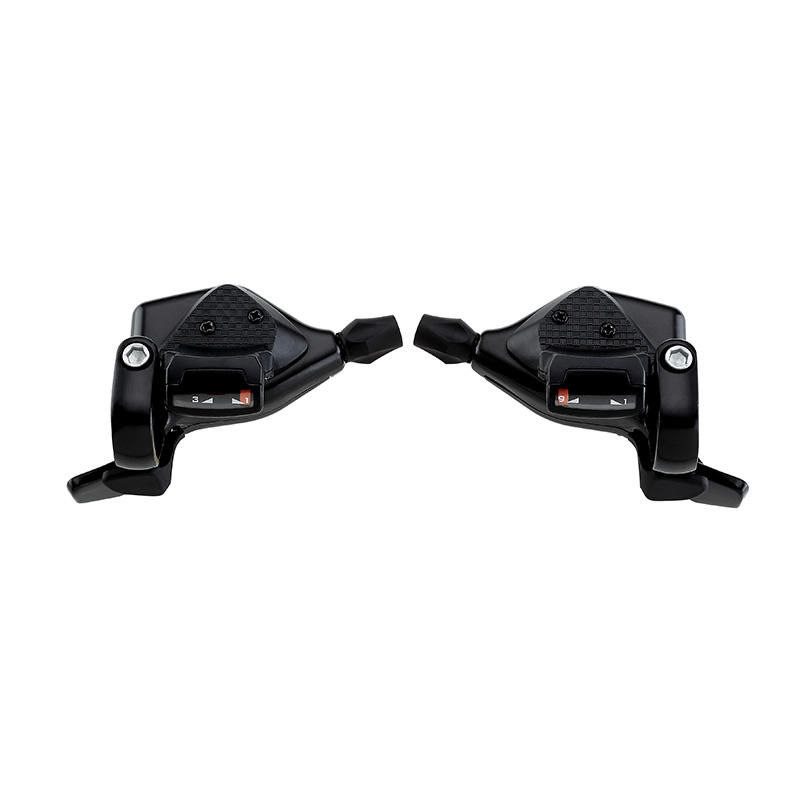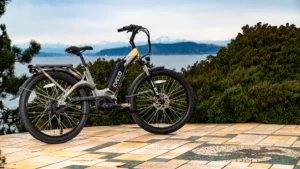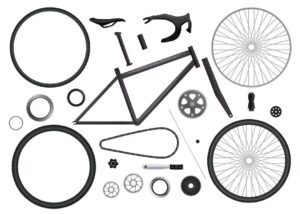في صناعة الدراجات, الآلية التي تغير من خلالها - مغيرات الدراجة العليا - محورية في تجربة الركوب الخاصة بك. من التعديلات السريعة على التسلق الحاد إلى انتقالات سلسة على النزول المتعرج, يمكن أن يؤثر نوع Syfter الذي تختاره بشكل كبير على أدائك والتمتع به. دعنا نتعمق في الأنواع المختلفة من محولات الدراجات لفهم وظائفهم, المزايا, واعتبارات عند اختيار أفضل خيار لاحتياجات ركوب الدراجات الخاصة بك.

الأنواع الرئيسية من المغيرات على الدراجات
مغيرات الدراجات تعال في أشكال مختلفة, كل ما يقدم مزايا فريدة مصممة خصيصًا لأنماط ركوب وتفضيلات مختلفة. إن فهم هذه الأنواع يمكن أن يمكّنك من اتخاذ قرار مستنير عند ترقية أو اختيار دراجة جديدة. ها هي 6 مغيرات الدراجات المختلفة:
تحولات الزناد
تعد مبدلات الزناد من بين الأنواع الأكثر شيوعًا الموجودة على الدراجات الحديثة, المعروف بتصميمهم البديهي ووظائفها المريحة.
كيف تعمل المغيرون الزناد?
تعمل مبدلات الزناد مع آلية رافعة تسمح للركاب بتغيير التروس عن طريق الضغط أو سحب المشغلات المدمجة في المقاود.
إيجابيات وسلبيات مغيرات الزناد
إيجابيات: يوفر محولات الزناد تغييرات دقيقة للعتاد, سهلة الاستخدام حتى في الظروف الصعبة, وتقديم قدرات سريعة التحول.
سلبيات: يجد بعض الدراجين محولات الزناد أقل راحة للاستخدام الممتد مقارنة بالتصميمات البديلة مثل مقايضة القبضة.
مغيرات قبضة
يمكن التعرف على مباريات القبضة من خلال آلية قبضة التلف, يوفر نهجًا مباشرًا لتتغير الترس مباشرة من المقاود.
كيف تعمل مغيرون قبضة?
تعمل محولات القبضة عن طريق التواء قبضة إما عقارب الساعة أو عكس اتجاه عقارب الساعة لتحريك derailleur وضبط التروس.
إيجابيات وسلبيات مقايضة المقبلة
إيجابيات: يتم تفضيل مباريات قبضة البساطة وتكاملها السلس مع قبضة المقود, توفير شعور طبيعي لتعديلات التروس.
سلبيات: يمكن في بعض الأحيان تنشيطها عن طريق الخطأ من قبل المتسابقين بأيدي أكبر أو عند التفاوض على التضاريس الوعرة.
مباريات الإبهام
مباريات الإبهام, على الرغم من أنه أقل شيوعًا في ركوب الدراجات الحديثة, تظل شائعة بين بعض عشاق الدراجات لسباقهم وموثوقيتهم.
كيف تعمل مبدلات الإبهام?
عادة ما تتألف مقايضات الإبهام من رافعات مثبتة على المقاود أو السفلي, السماح للركاب بتحويل التروس عن طريق الضغط على الرافعات مع إبهامهم.
إيجابيات وسلبيات مبدلات الإبهام
إيجابيات: مبدلات الإبهام متينة, خفيف الوزن, وتقديم تغييرات دقيقة للعتاد دون الحاجة إلى حركة يد كبيرة.
سلبيات: قد يطلبون من الدراجين إطلاق قبضتهم على المقاود لحظات لتغيير التروس, والتي يمكن أن تؤثر على السيطرة في التضاريس التقنية.
المحولات نهاية نهاية
غالبًا ما يتم العثور على مبدلات نهاية الطرف في جولة ودراجات على الطرق, تقديم موضع متميز في نهايات المقاود لتغييرات الترس الفعالة.
كيف تعمل المحولات نهاية الشريط?
تعمل مباريات نهاية الطرف من خلال دفع أو سحب الرافعات الموجودة في نهاية الشريط, السماح بالتحكم الدقيق في تعديلات التروس.
إيجابيات وسلبيات المغيرون نهاية الشريط
إيجابيات: توفر مباريات نهاية نهاية العرض مجموعة واسعة من خيارات التروس, تعزيز الديناميكا الهوائية عن طريق الحفاظ على مقاود خالية من الفوضى, وهي متينة لركوب المسافات الطويلة.
سلبيات: أنها تتطلب تعديل طفيف في وضع الركوب للوصول إلى المغيرات, التي قد لا تروق لجميع راكبي الدراجات, خاصة تلك التي تركز على الوصول السريع إلى التروس.
تحيزات الهبوط
كانت مبدلات الهبوط في كل مكان في كل مكان في ركوب الدراجات ولا يزالون مفضلين من قبل الأصوليين وعشاق الدراجات القديمة من أجل بساطتهم وجمالهم الرجعية.
كيف تعمل مبدلات الهبوط?
يتم تثبيت مبدلات Downtube على أسفل إطار الدراجة, السماح للركاب بتحويل التروس عن طريق الوصول إلى أسفل وتحريك الرافعات يدويًا.
إيجابيات وسلبيات مغيرات الهبوط
إيجابيات: تحيلات الهبوط خفيفة الوزن, موثوق, وتوفير اتصال ميكانيكي مباشر مع Derailleur لتغييرات الترس الدقيقة.
سلبيات: أنها تتطلب تعديلًا كبيرًا في الموقف للركوب لتغيير التروس, والتي يمكن أن تكون غير مريحة أثناء ركوب الدراجات السريعة أو ركوب الدراجات التنافسية.
المغيرون الإلكترونية
تمثل المحولات الإلكترونية تقنية متطورة في ركوب الدراجات, تقديم دقيق, يتغير التروس السريع للبرق من خلال الإشارات الإلكترونية.
كيف تعمل المغيرون الإلكترونيون?
تستخدم المثلات الإلكترونية المحركات الكهربائية وأجهزة الاستشعار لتسهيل تغييرات التروس, ضمان انتقالات سريعة ودقيقة بين التروس.
إيجابيات وسلبيات المغيرات الإلكترونية
إيجابيات: المغيرون الإلكترونيون دقيقون للغاية, تتطلب الحد الأدنى من الجهد للعمل, ويمكن تخصيصها لظروف ركوب وتفضيلات مختلفة.
سلبيات: عادة ما تكون أغلى من المتبادلون الميكانيكية, تتطلب شحن البطارية أو الصيانة في بعض الأحيان, وقد يكون أقل ملاءمة لمواقع ركوب الدراجات عن بُعد دون الوصول إلى الطاقة.
كيفية اختيار أفضل شيفتر دراجة?
يعد اختيار شيفتر الدراجة المثالي أمرًا ضروريًا لتحسين تجربة ركوب الدراجات, سواء كنت تتنقل في شوارع المدينة, معالجة مسارات صعبة, أو الشروع في مغامرات المسافات الطويلة. إليك دليل شامل لمساعدتك على التنقل في خيارات لا تعد ولا تحصى المتاحة والعثور.
التوافق مع مكونات الدراجة
تأكد من التوافق بين شيفتر المختار ومكونات الدراجات الأخرى مثل derailleur و cassette. على سبيل المثال, إذا كنت تبحث على وجه التحديد عن أفضل شيمانو 9 شيفتر السرعة, تحقق من أنه يتطابق.

تألق قريبا TP-190016 هو نظام قيادة من الألومنيوم الأسود 9 شيفتر السرعة المتوافق مع شيمانو. إنه يضمن انتقالات التروس السلسة والأداء الأمثل.
ركوب النمط وتوافق التضاريس
الخطوة الأولى في اختيار شيفتر دراجة هي النظر في أسلوب ركوبك والتضاريس التي تتكرر. إذا كنت تستمتع بركوب سريعة على التضاريس المتنوعة, قد يكون شيفتر سريع الاستجابة ودقيق مثل الزناد أو شيفتر إلكتروني مثاليًا. على الجانب الآخر, إذا كنت تفضل وتيرة أكثر استرخاء أو معالجة المسارات الفنية, قد يوفر شيفتر قبضة أو شيفتر نهاية شريط تحكم وراحة أفضل.
سهولة الاستخدام وبيئة العمل
الراحة وسهولة الاستخدام هي اعتبارات أساسية. اختبر أنواعًا مختلفة من أنواع الحفر لمعرفة ما هو أكثر طبيعية بين يديك ويندمج بسلاسة مع مقود دراجتك أو إطارك. يمكن للمغيرات المصممة بشكل مريح تقليل التعب أثناء ركوب الخيل الطويلة وتوفير وصول سريع إلى التروس عند الحاجة.
متطلبات المتانة والصيانة
تقييم احتياجات المتانة والصيانة لكل نوع من أنواع الحفر. المغيرات الميكانيكية مثل محولات الزناد والقبضة قوية بشكل عام وتتطلب الحد الأدنى من الصيانة. المغيرون الإلكترونية, بينما تقدم التحول الدقيق, قد تحتاج إلى تحديثات بطارية أو تحديثات البرامج الثابتة من حين لآخر.
اعتبارات الميزانية
حدد ميزانية توازن بين الميزات والفوائد التي تريدها مع القدرة على تحمل التكاليف. غالبًا ما تكون المحولات الميكانيكية أكثر فعالية من حيث التكلفة في البداية, في حين أن المغيرات الإلكترونية تمثل استثمارًا أعلى أعلى ولكن قد يقدمون فوائد طويلة الأجل من حيث الأداء والراحة.
سمعة العلامة التجارية
النظر في سمعة العلامة التجارية تصنيع الحافة. العلامات التجارية المنشأة مثل تألق قريبا, شيمانو, Sram, وقد حصل Campagnolo على ثقة في إنتاج مكونات دراجة موثوقة ومبتكرة. يمكن أن يقدم اختيار العلامة التجارية ذات السمعة الطيبة ضمانًا من حيث الجودة ودعم العملاء.
خاتمة
ختاماً, توفر أنواع مختلفة من مبدلات الدراجات مجموعة متنوعة من الخيارات لتناسب احتياجات كل متسابق وتفضيلاته. سواء كنت تعطي الأولوية للبساطة, دقة, أو التكنولوجيا المتطورة, هناك نوع شيفتر مصمم لتعزيز تجربة ركوب الدراجات الخاصة بك. من خلال فهم الميكانيكا, المزايا, واعتبارات من كل نوع - من مقايضات الهبوط التقليدية إلى الأنظمة الإلكترونية المتقدمة - يمكنك اختيار أفضل مجموعة من أفضل دراجة لرفع التمتع والأداء.

















